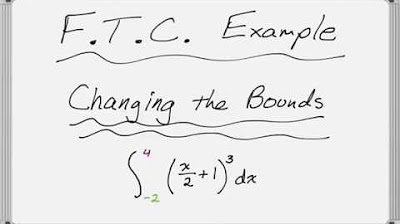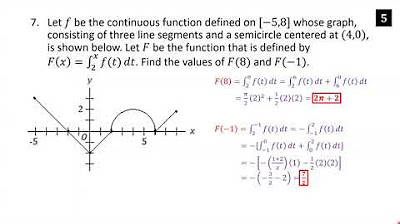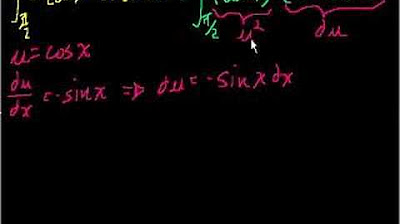Definite integral of piecewise function | AP Calculus AB | Khan Academy
TLDRThe video script presents a step-by-step explanation of how to evaluate a piecewise function's definite integral. It introduces the function f(x) and explains the process of splitting the integral into two intervals to handle the piecewise definition. The script then demonstrates the calculation of the integral from -1 to 0 using basic antidifferentiation, resulting in a value of 1/2. Next, it tackles the integral from 0 to 1 by applying u-substitution to the cosine function, ultimately yielding a result of 0. The final answer for the entire definite integral is the sum of both parts, which is 1/2.
Takeaways
- 📌 The function f(x) is defined piecewise, with f(x) = x + 1 for x < 0 and f(x) = cos(πx) for x ≥ 0.
- 📈 The definite integral of f(x) from -1 to 1 is evaluated by splitting the integration interval into two parts due to the piecewise definition of the function.
- 🤔 The first part of the integral, from -1 to 0, uses the antiderivative of x + 1, which is (x^2)/2 + x.
- 🧮 Evaluating the first part at x = 0 and x = -1 gives a result of 1/2 after applying the limits of integration.
- 📌 The second part of the integral, from 0 to 1, involves the function cos(πx), which requires a technique like u-substitution to find its antiderivative.
- 🔄 The substitution u = πx is used, and the derivative of sin(πx) with respect to x is found using the chain rule, resulting in πcos(πx).
- 🎓 To adjust for the substitution, the integral is multiplied and divided by 1/π, which does not change the value but aligns with the derivative of sin(πx).
- 📊 The antiderivative of cos(πx) is sin(πx), and the integral is evaluated from 0 to 1, resulting in a final value of 0 because sin(π) - sin(0) = 0.
- 🔢 Combining the results from both parts of the integral, the total value of the definite integral from -1 to 1 is 1/2.
- 🌟 The process demonstrates the importance of understanding the piecewise nature of functions and the appropriate techniques to evaluate their definite integrals.
- 📚 The example serves as a lesson in the application of basic calculus concepts such as antiderivatives, u-substitution, and the evaluation of definite integrals.
Q & A
What is the function f(x) defined as for x less than zero?
-For x less than zero, the function f(x) is defined as x plus one.
How is the function f(x) defined for x greater than or equal to zero?
-For x greater than or equal to zero, f(x) is defined as the cosine of pi x.
What is the purpose of splitting the definite integral from negative one to one into two parts?
-The purpose of splitting the definite integral is to simplify the process by separating the regions where the function f(x) has different definitions.
What is the antiderivative of x plus one with respect to x?
-The antiderivative of x plus one with respect to x is x squared over two plus x.
How do you evaluate the definite integral from negative one to zero of f(x) dx?
-By evaluating the antiderivative of x plus one at zero and negative one, the definite integral from negative one to zero is found to be positive 1/2.
What is the antiderivative of cosine of pi x with respect to x?
-The antiderivative of cosine of pi x with respect to x is sine of pi x.
How can you apply u-substitution to the integral of cosine of pi x?
-By setting u equal to pi x and using the chain rule, you can determine that the derivative of sine of pi x with respect to x is pi cosine of pi x, leading to the antiderivative being sine of pi x.
What is the result of the definite integral from zero to one of cosine of pi x dx?
-The definite integral from zero to one of cosine of pi x dx evaluates to zero, as sine of pi times one minus sine of pi times zero equals zero.
What is the final result of the definite integral from negative one to one of f(x) dx?
-The final result of the definite integral from negative one to one of f(x) dx is 1/2, as the sum of the two parts (1/2 and 0) equals 1/2.
Why is it important to split the integral at x equals zero?
-Splitting the integral at x equals zero is important because it is the point where the function f(x) changes its definition, and this helps in evaluating the integral of each piece separately.
How does the chain rule help in finding the antiderivative of cosine of pi x?
-The chain rule helps in finding the antiderivative of cosine of pi x by allowing us to differentiate the composite function sine of pi x, which results in pi cosine of pi x as the derivative, leading to the antiderivative being sine of pi x.
Outlines
Piecewise Function Integration 📚
This paragraph discusses the process of evaluating the definite integral of a piecewise function. The function is defined as f(x) = x + 1 for x < 0 and f(x) = cos(πx) for x ≥ 0. The integral is evaluated from -1 to 1, and it's noted that the function changes at x = 0. The definite integral is split into two parts to simplify the process: from -1 to 0 and from 0 to 1. The antiderivative of the first part (x + 1) is found to be (x^2/2) + x, and when evaluated from -1 to 0, it results in a value of 1/2. The second part involves the function cos(πx), and the technique of u-substitution is introduced to find its antiderivative, which is sin(πx). However, after applying the chain rule and adjusting for the factor of π, the derivative of sin(πx) is identified as πcos(πx), leading to the antiderivative being 1/π * sin(πx). When evaluated from 0 to 1, this integral evaluates to 0, as sin(π) - sin(0) equals 0.
Result of the Definite Integral 📈
In this paragraph, the results of the previously calculated integrals are combined to find the total definite integral from -1 to 1 of the piecewise function. The first part of the integral, which is from -1 to 0, evaluates to 1/2. The second part, from 0 to 1, evaluates to 0 because of the properties of the sine function. Therefore, the combined result of the definite integral is 1/2 + 0, which simplifies to 1/2. This final value represents the area under the curve of the piecewise function between -1 and 1 on the x-axis.
Mindmap
Keywords
💡Piecewise function
💡Definite integral
💡Antiderivative
💡u-substitution
💡Chain rule
💡Fundamental Theorem of Calculus
💡Cosine function
💡Sine function
💡Trigonometric functions
💡Evaluation
💡Area under the curve
Highlights
The definite integral of a piecewise function is evaluated by splitting the integration interval.
The function f(x) is defined piecewise: f(x) = x + 1 for x < 0 and f(x) = cos(πx) for x ≥ 0.
The definite integral from negative one to one of f(x) dx is split into two integrals: one from negative one to zero and another from zero to one.
The antiderivative of x + 1 is found by incrementing the exponent and dividing by the new exponent.
The antiderivative of x + 1 is evaluated at zero and negative one to find the definite integral from negative one to zero.
The definite integral from negative one to zero evaluates to positive 1/2.
The antiderivative of cos(πx) is found using the chain rule and the fact that the derivative of sin(πx) is πcos(πx).
The integral from zero to one of cos(πx) dx is evaluated using u-substitution with u = πx.
The derivative of sin(πx) with respect to x is πcos(πx), which is used to find the antiderivative of cos(πx).
The antiderivative of cos(πx) is sine of πx, and the integral from zero to one is evaluated by substituting the limits into the antiderivative.
The integral from zero to one of cos(πx) evaluates to zero because sine of π and zero both equal zero.
The final result of the definite integral from negative one to one is 1/2, combining the results from both intervals.
The method of splitting the integral into intervals is useful for handling piecewise functions with different expressions.
The use of u-substitution and the chain rule is demonstrated for dealing with trigonometric functions in integral calculus.
The process of evaluating definite integrals involves finding antiderivatives and applying the Fundamental Theorem of Calculus.
This transcript provides a step-by-step guide on evaluating a definite integral involving a piecewise function and trigonometric substitution.
The importance of correctly applying the limits of integration when evaluating antiderivatives is emphasized.
The transcript showcases the application of calculus techniques in solving mathematical problems involving piecewise-defined functions.
Transcripts
Browse More Related Video

Fundamental Theorem of Calculus: Changing the Bounds with u-Substitution

The Definite Integral Part III: Evaluating From The Definition

Definite integral of absolute value function | AP Calculus AB | Khan Academy

AP Calculus AB Crash Course Day 8 - Integration and Riemann Sums

Periodic Definite Integral

Definite integral with substitution
5.0 / 5 (0 votes)
Thanks for rating: